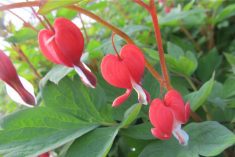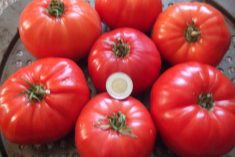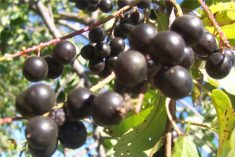Thanks again to faithful readers for joining me on the Singing Gardener page and a golden hello and handshake to first-timers. Welcome to Ted’s world of words. At times my subject material can go beyond strictly gardening and may also include matters pertaining to health and wellness, recipes, music, folklore and even something historical.
For example, who was Skookum Jim? There are hundreds of men and women beyond politicians whose names may not be so familiar, yet they made significant historical contributions within society and in their regions and communities in Canada. Take your best guess from the following three questions (look for the answers just above my closing tag).
Who was Skookum Jim?
Read Also

Gentle treatments for pain in the neck
Heading toward year-end, people unknowingly tense up against the cold and busyness, causing neck pain that can often be treated with appropriate support and gentle mobility, athletic therapist Kathlyn Hossack says.
1. A prospector who panned the first Klondike Gold Rush discovery
2. A stagecoach proprietor in Upper Canada
3. A pioneer oilman who invested with Black Creek Investments
There’s a lot to say about poppies in this November 2022 issue of Grainews. Red poppies in particular initiate memories and extend an invitation to meditate, pray on and ponder the significance of Remembrance Day. May each individual never lose sight of the important reasons for wearing a symbolic poppy on the left side over your heart. I’m up and at it and ready to press on with my standard tip o’ the hat greeting.

How wearing a red poppy began
During the First World War in Flanders Fields in Belgium, red poppy seeds lying dormant began to germinate and pop up everywhere, flowering on disrupted soil, mounds of rubble and craters where bombs had fallen. Heavily churned earth seemed the perfect catalyst for poppies to grow.
It was around 1920 the first reports of someone wearing a poppy in memory of lives lost during the Great War came out. Word spread of a woman from France who became known for making poppies to wear and selling them to help support children of war victims. Her idea quickly spread and memorial poppies have been used for similar fundraising purposes ever since.
Here in Canada, memorial poppies are available through the Royal Canadian Legion with the proceeds benefiting veteran organizations and Legion projects that assist veterans and their families. When you see a volunteer with poppies, or notice Remembrance Day poppies being displayed somewhere, anything you contribute is received with deep appreciation. Out of respect and togetherness, we recall all of those who died or were harmed while serving their country. Memorial poppies touch and inform everyone from children to seniors and remind us to give thanks to each and every man and woman who ever belonged to or is now serving with the Canadian Armed Forces.

The following words are from a song written and performed by Terry Kelly. “Take two minutes, would you mind? It’s a pittance of time for the boys and the girls who go over. In peacetime our best still don battle dress, and lay their lives on the line, it’s a pittance of time. In peace may they rest, lest we forget why they died, take a pittance of time.”
May we never lose sight of the importance, the feel for and the reason why we set aside November 11 as Remembrance Day.
Poppies are charming, dazzling, spectacular in the garden
Each summer, I admire the beauty of annual and perennial garden-grown poppies and always connect with their close association with Remembrance Day. Some know-how does help when growing poppies. Their seeds require exposure to cold temperatures before they will reliably germinate. Poppies can be sown outdoors in autumn before frost or in early spring in cool soil as soon as the ground thaws. Select a growing site with mostly full sun or partial shade. At least six hours of daily sunshine is ideal but it’s best to try to avoid exposure to midday intense heat of the afternoon.
Mixing poppy seeds with sand has its benefits. Place seeds in a small container such as a vitamin bottle or glass jar. Add some sand, about twice as much by volume as the poppy seeds, then mix or shake to separate. Poppy seeds are quite tiny and easily clump together, and sand helps space them out so they stay apart. Lightly cover the seeds with fine soil. Nature does the rest.
Annual poppies of the same colour can self-pollinate and reproduce true to the original parent. If cross-pollinated with other colours and varieties, the next generation of offspring will be a blend between the parent poppies. If you want poppies to be all the same, then plant only seeds of that colour and variety. Regardless, there can still be some cross-pollination with other poppies in the vicinity by insects and wind.
In the garden, most poppy flower petals will usually fall off or be blown away by breezes after about 48 hours. Each poppy plant focuses on producing pods filled with mature, viable seeds, which drop to the ground for self-preservation. Seed heads can be collected in brown paper bags and saved for future planting or to make poppy seed cakes and muffins. If poppies like your garden, they will keep coming annually.
Fresh cut flowers
A common statement is, “If only freshly cut poppies would keep longer.” However, there are some poppies whose cut flowers are known to stand up well in a vase with water. The true annual wild form of red field poppy (Papaver rhoeas) is the parental forerunner of today’s annual Flanders and Ladybird poppies. Their brilliant, bright red flowers with a black seed blob at the base of the petals create a memorable impression. They grow up to two feet or 60 centimetres tall. To purchase seeds, visit a garden centre (many are open year-round) and check out their seed displays, or order via a seed catalogue or by email.
Other poppies suitable for fresh cutting include feathered poppies (Papaver laciniatum). Scrumptious is the word that leaps to mind once a gardener sees the huge, full double flowers with numerous ostrich-like feathers for petals. Inescapable blooms up to five inches or 12 centimetres across are generously borne on long, sturdy stems all summer. They are good for fresh cutting and the seed heads when dried are useful in arrangements. The seeds are available in two colours — Crimson Feathers, which produce fluffy balls of deeply cut crimson petals, and Swansdown, which bloom in snow-white ostrich feathery plumes.
There’s also a mixture of seeds called Fluffy Ruffles. They come in a complete colour range and produce hardy annual plants growing up to three feet or one metre tall. Then there’s Illumination (Papaver nudicaule) — the Iceland poppy with colourful satin-like flower petals. Its flowers are known to last well in water. In some growth hardiness zones, Illumination is a hardy perennial, and in others, a biennial.
Poppy seeds for the described flowers can be purchased from Chiltern Seeds, Wallingford, Oxfordshire, 0X10 6SL, England. You can check out their poppy selections at www.chilternseeds.co.uk.
Remembering Skookum Jim
Skookum Jim helped kick-start the Klondike Gold Rush in the Yukon. Historic as his name is, it seldom appears in history publications and that’s unfortunate. Born with the name Keish in the First Nations community of Tagish, Yukon, he later became known as Skookum (strong) Jim for his ability to haul huge loads on the Chilkoot Trail. As a prospector, Skookum Jim panned the first nugget, which set off the gold rush in 1896. His mining property and skills eventually earned him a respectable $90,000 annually. Skookum Jim continued his prospecting ventures and did well financially to the end. He died in 1916.

















